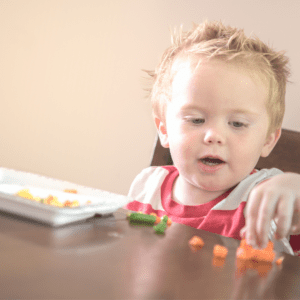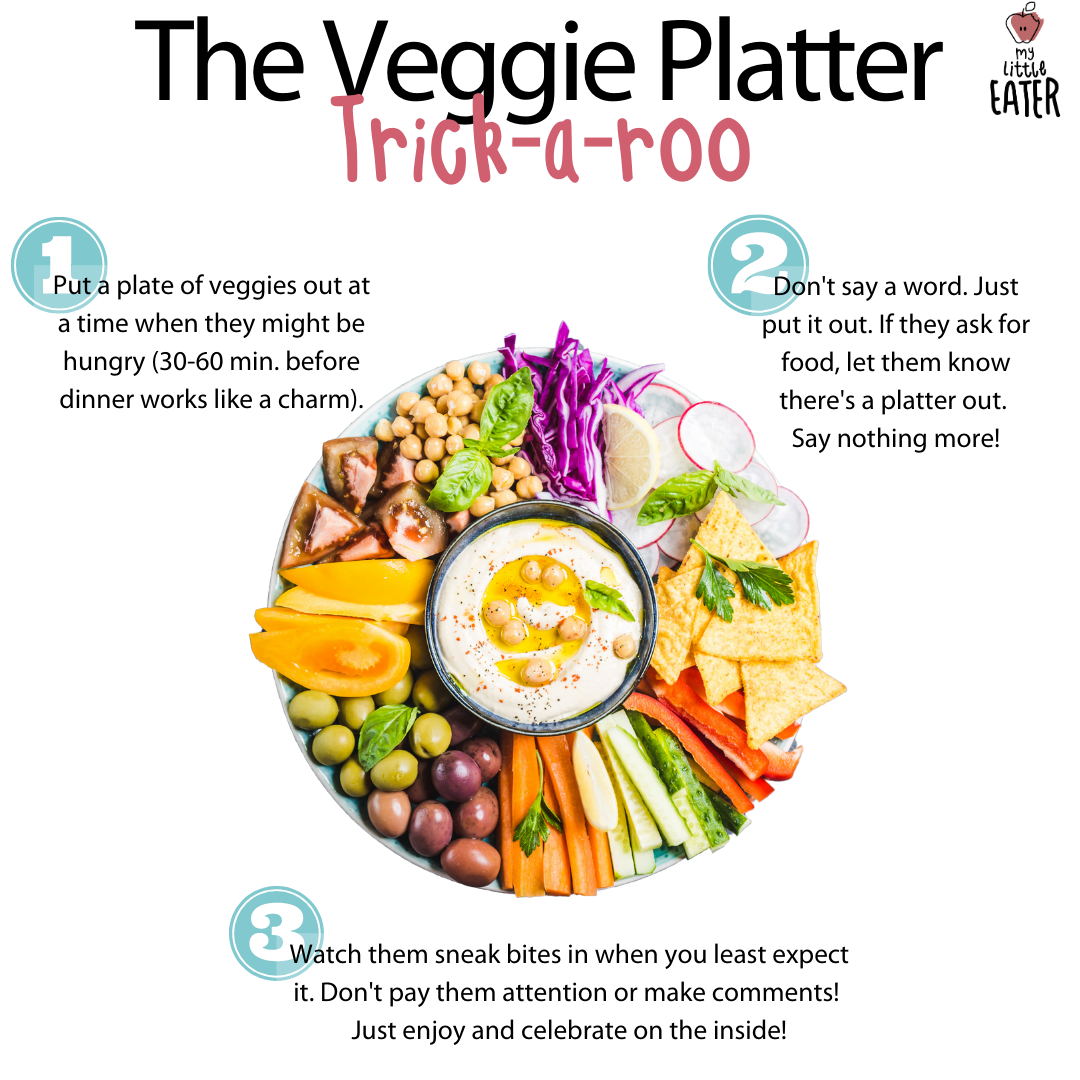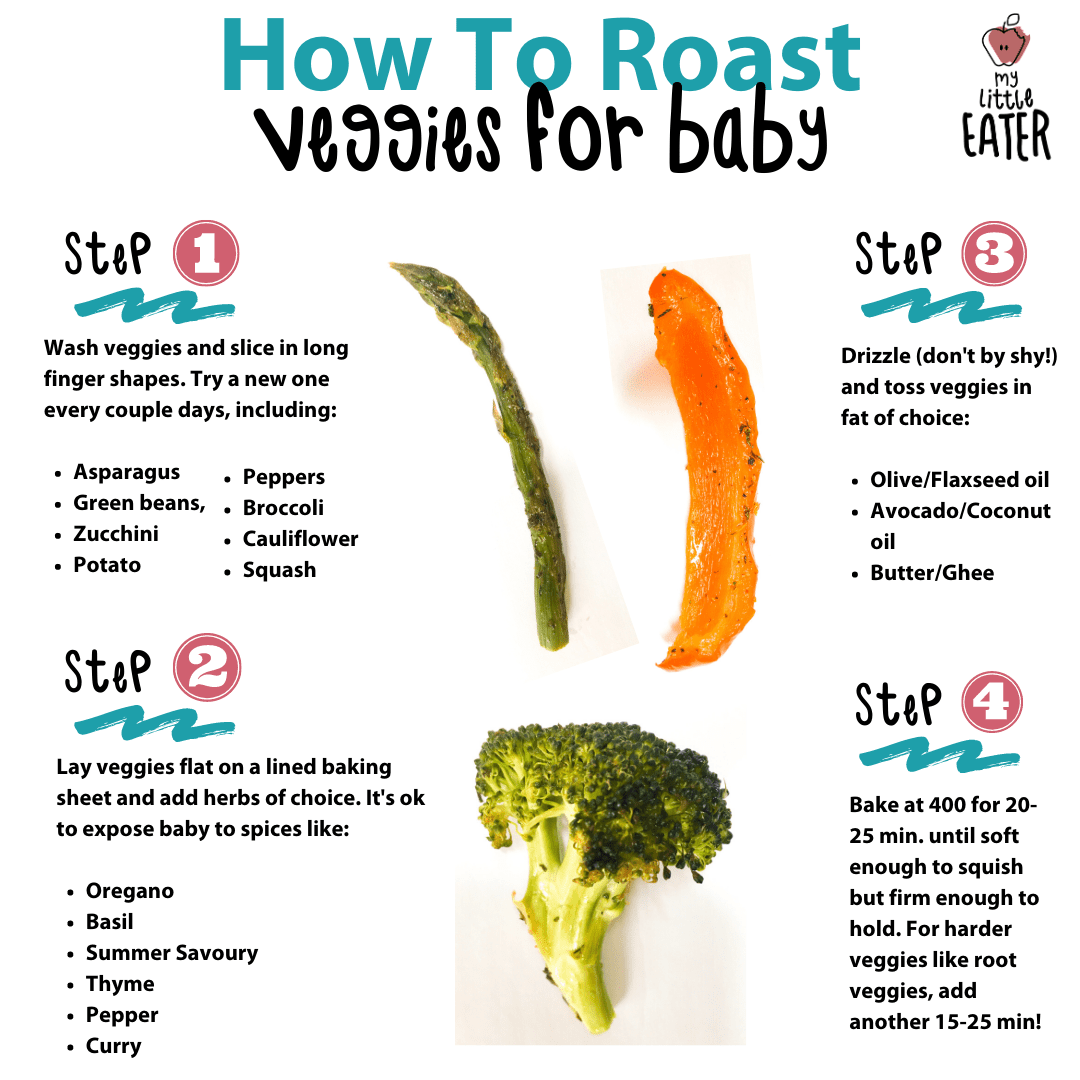
Have you ever made a delicious meal – veggies, roasted chicken and pasta – only to have your child eat everything except all the veggies? Yeah, you’re not the only one. Seems like the battle between kids and veggies has been set in stone since the beginning of time. And it longs to continue. Part of this battle can be attributed to neophobia – a fear of new foods, which is something most toddlers go through and usually outgrow later. I’m sure as a parent you’ve noticed this already during mealtimes, but don’t let this discourage you!
I often get the question “How do I get my toddler to eat more veggies?”.
Ummmm, here’s the thing…we can’t get or make our toddler eat anything.
There’s really no magical solution and we certainly don’t want to force them to eat them. That does nothing for teaching them to actually like them or have a healthy relationship with food. The decision to eat veggies or any food for that matter, has got to come from them.
But even though the decision to eat them, or not to eat them, will always be in their hands, there are definitely things you can do to help make them more appealing, to peak their curiosity and to increase the number of times they at least try them (which eventually leads to liking them!). The strategies that I’ll be covering today have been used on my boys many times before, and can help you strategically make veggies less of an enemy, and more of a mealtime friend.
Total disclaimer: this is a long game we’re playing here people. Don’t expect overnight success, and especially if the consistency in these strategies and the others I teach isn’t happening.
Ok ready?
Here we go!
Let veggies show up at every meal
Think about this…most times when veggies (especially new veggies) are presented, they’re done at dinner time, when your child is likely tired, cranky and full from a full day of eating. Many parents aren’t conscious of the fact that they haven’t served veggies at other meals and snacks, and yet are surprised when their toddler refuses them the one time it shows up in the day. When your toddler sees other foods like grains or dairy show up over multiple meals/snacks, and yet veggies are only present at one (maybe two) eating opportunities a day, they come to learn to like what’s showing up more often.
For this reason, you should aim to serve veggies not only at bigger meals, like dinner, but also with breakfast or lunch, and at least one snack per day. The earlier in the day they are included in meals, or the hungrier they are, the higher the the chances that they’ll eat them. If you can’t always have them present at all three meals…no biggie. But by golly try to, especially if you have a toddler that freaks out from veggies. The more they fear it, the more you need to (positively) expose them to it.
You don’t need to get too fancy…just some a couple of raw or cooked veggies alongside a sandwich is fine. You can add veggies to an afternoon snack that you already know they love, like adding cucumber slices to their crackers and cheese or celery with some peanut butter spread on or cherry tomatoes and hummus dip. Try to offer a variety throughout the day. Keep cycling different veggies into your meal plan, and try not to serve the same veggies over and over, or for more than one meal in a day. This can help expose them to greater amounts of veggies. and lets them know to expect them as part of each meal. Because ultimately, we want them to get used to seeing veggies every single meal (or at 80% of their meals). It means more exposure, more familiarity, more of a chance they’ll learn to like them.
One amazing trick I use for snack time is to set out a veggie plate right before a meal while they are really hungry and waiting for you to be finished cooking. Be discrete, and don’t give an explanation, just simply place a plate of raw, cut-up veggies with a dip of choice out on the table and let them calm their hunger with it before mealtime starts.

You really don’t have to say a bunch of stuff (or anything at all) to entice them. It may do the opposite in fact. Don’t say “ooooh look at what I have for you!” or “Look at how good these veggies look!” or anything. Not making a big deal out of it is important. ⠀
⠀
They may notice it right away, or it may take them a while before they realize it’s there. Maybe the notice it, and they pay no interest to it (cause they’re veggies after all). BUT….watch out of the corner of your eye. Eventually, MOST times kids (even those who “hate” veggies), will slowly start to creep up on it. They’ll look at it, pick one up, take a bite, resume doing what they were doing before…and then come back to it. Next thing you know, they’ve eaten more veggies than they’ve ever eaten before!⠀
⠀
Again…refrain from making a big deal! Once they see you’re happy they “finally” ate veggies…they’ll usually back track cause…you know…they’ll know you care so much and the power struggle begins again.⠀
⠀
The good thing is that veggies and dip won’t necessarily fill them up too much before an actual meal is served, and they get all those nutrients in before their meal has actually began. Takes a lot of pressure off for you worrying about them eating veggies at mealtime! If you have other foods you’re trying to get your toddler to try eating, go ahead and try putting them out on a platter too! Follow the same strategies…no coaxing or talking about it. Let them ease into it themselves.⠀
Don’t make veggies seem like a chore
Do you ever find yourself being so focused during mealtime on getting your child to eat their veggies, it almost becomes a chore you have to complete in order to consider it a successful meal? Listen, meal times are meant to be a fun and relaxing time – so doing this during every meal is no fun for you, or them, and unfortunately, can turn them off from veggies even more.
Think about how you would present ice cream to your child. We often get super excited, show delight and talk about how lucky they are to get a special treat. Now think about how we typically serve and talk about veggies. We make our toddlers feel like it’s required to eat and it’s not the highlight of the meal. We coax them to take a bite, we try to convince them of how good or healthy they are for them. We even refuse to allow them to end the meal before a minimum amount of veggies are eaten. As a result, kids feel the burden of eating veggies and funny enough, the more we show an emotional response to their acceptance or refusal of veggies, the more the pickiness continues. Take a look at my previous blog post on how pressure during mealtimes, like this, can make things much worse.
Instead of focusing fully on how much they’re eating, focus on enjoying mealtimes and helping them explore the characteristics of all the veggies being served. Pay attention to the language and way that you present veggies at a meal, compared to say dessert. Toddlers are very smart and very influenced by their parents behavior. Make sure to show them that you are enjoying the veggies on your plate! By helping them explore each vegetable with curiosity, they won’t feel like they are being pressured and you’re on your way to having a more adventurous eater in the future.
Which leads me to my next point…
Play with, talk about and explore veggies!
No one said veggies have to stay boring and no one said exposure to veggies had to stay at the table! Exploring them through play and food exploration can help increase the chances that they’ll eat it. Food play can help them learn about the characteristics of each veggie – if it’s soft, hard, or crunchy for example, and let them become more comfortable with them, which is the goal at first. They can’t eat what they’re not comfortable with. You can of course do food play at the table, but it can also be done during craft time, or when you’re preparing dinner, for example. Below are some games you could play which can help make this even more fun.
- Tic Tac Toe – use asparagus sticks to make the board, or another long veggie (zucchini sticks, green beans, etc.), and use coined carrots, peas, corn, or two other veggies of choice, as the game pieces.
- Beet stamps – cut a beet in half and cut out a shape of choice on the inside edge of the beet. Use it to make fun and pretty stamps!
- Food Puzzles – use veggie cutters, like I mentioned above, to make puzzle pieces. An easy way to do this is to use carrot or zucchini matchsticks and let them try to fit the cut outs back into the right spot on the matchsticks
Another great way to get them exploring veggies is to get them involved in veggie prep in the kitchen. Channeling their inner chef at a young age can go a long way in eliminating any uncertainty they have with veggies, and lets them become more familiar with them on their own terms. Their tasks don’t have to be huge, or dangerous. Depending on their age, they could simply wash the veggies, break broccoli apart, and place them into whatever dish you’re making. Older children could use a child safe knife and help you prepare them. You might even find them nibbling on them during prep time!
Also….check out my blog post on how I got my kids to like beets.
Finally, another biggie in the “get-your-kids-to-eat-veggies” world is to grow a garden with veggies! Seriously, there is so much research out there that continues to show the benefits that growing a garden can have on kids’ vegetable intake. It’s a great way to introduce them to new types of veggies, helps them learn where it comes from, and gives them a sense of pride and accomplishment when they grow their own. Once this happens, you better bet that they’ll be declaring love at first sight once they see that veggie harvested and on their plate. Something they have come to understand. How else do you think I got my son to love radishes so much?!
Make them taste good
No one wants to eat bland, boring and mushy boiled brussel sprouts. So don’t expect your kid to want to have them either! The way that you cook, top, and season your veggies can make all the difference for a toddler who has never tried them before. Compared to their sweeter fruit counterparts, veggies are known to be bitter, bland, and lack an appealing taste that interests kids. Since this is one of the most common reasons kids won’t give them the time of day, I like to use this as motivation and try different techniques to help eliminate the bitterness and be creative in my kitchen. You know, so you can stop constantly stressing about them being left on the plate every single meal!
Butter them up
Of course, this one is so well known, and was probably used by our parents too for the exact same reason. Adding butter works well, after steaming, and as a topper for some added flavour. You can also add butter to a frying pan and sauté your veggies in it too!
Make ’em cheesy
Let’s not ignore how delicious cheese is, or how it can play a role in a well balanced diet for your child either! Since cheese is usually tolerated well by kids, this is an easy addition to help make veggies tastier. Try sprinkling some parmesan cheese on top of roasted veggies, or melting it into other dishes that have veggies mixed in, like pasta for example. This can help get in more exposures, and as your child gets more comfortable with it, they’ll come to learn to accept veggies on their own.
Season them to add a variety of flavours
Seasoning can have huge potential to add much better flavours to any veggie without added salt or sugar. Some examples of staples I have in my kitchen are: thyme, parsley, oregano, garlic powder, rosemary, curry, turmeric, black pepper, and paprika – which I often pair with olive oil to help really get the seasoning coated on the veggies. Here are some pairings I recommend trying out next time you’re looking for a way to ramp up veggies for your mealtimes!
- Roasted zucchini with Italian seasoning and a drizzle of balsamic
- Roasted carrot with a touch of chilli powder and ground cinnamon
- Roasted sweet potato with paprika and garlic powder
- Roasted Broccoli with lemon and parmesan cheese
- Roasted Cauliflower with curry and onion powder
Dip ’em
It’s no secret that kids love dipping food into things – ketchup, water, anything they can get their hands on. I’ll use this as an advantage any day if it’ll help increase the likelihood they’ll at least try the veggies. Let’s be honest, dips are not only super fun for toddlers, but they mask bitter tastes really well and even provide familiarity at a meal that might otherwise be all new.
Here are some dip options that aren’t just delicious, but offer a nutrient dense pairing for a variety of vegetables.
- Hummus
- Tzatziki
- Plain yogurt
- Guacamole
- Marinara
- Garlic dip
- Pesto
- Oil and vinegar
- Mayo
- Ranch dressing
Dips like ketchup and BBQ sauce, which may have higher sugar content, can stress a parent out when their toddler is dunking everything in it. But my advice is not to stress too much about this. If dips like these entice them to try food like veggies (which may otherwise be turned down), then focusing on this goal first is where you want to start.
Roast (instead of steaming or boiling) veggies
Boiling any vegetable removes appealing flavours, colour, crispiness, and textures they have to offer – plain and simple. On top of making them less nutrient dense too. This is why I recommend avoiding boiling as much as possible. Roasting vegetables, on the other hand, naturally caramelizes them, makes them sweeter, and in the long run, has potential to help your kids actually want to eat them. It essentially locks in all those nutrients and flavours and enhances them. Some vegetables that roast easy, and taste amazing are: carrots, green beans, asparagus, potatoes (sweet potatoes too), broccoli, and peppers.
Have a look at how I roast veggies at home!

With a little consistency, and patience, I know implementing these strategies can help your stress level decrease, and your child’s veggie intake increase! Win-win for both sides, if I do say so myself!
If you’re looking for more novel ways to include veggies in meals, or want to know the benefits of constant exposures with examples on how to rotate veggies in your child’s diet, check out my Feeding Toddlers online course. I cover both of these in separate modules that are more detailed and won’t just help with their veggie intake, but will also help encourage adventurous eating in the future!





